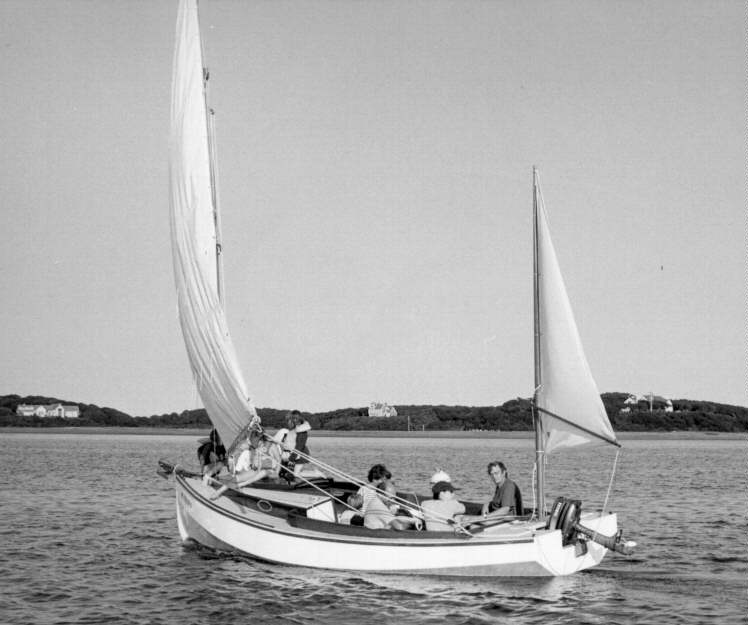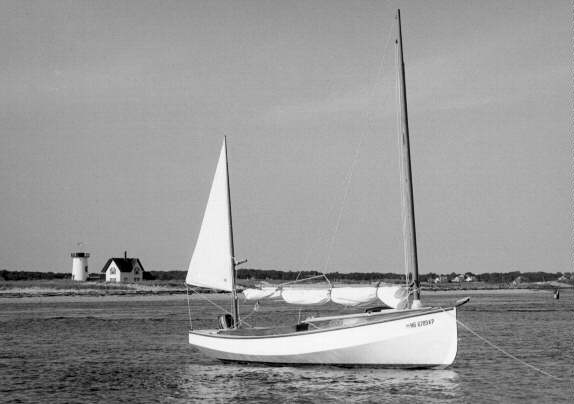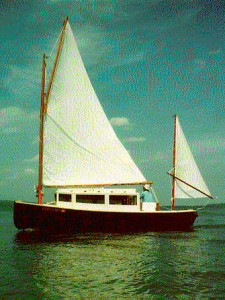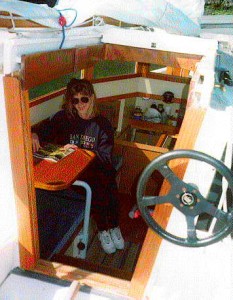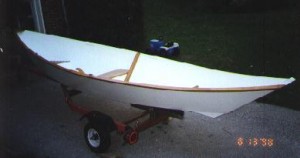Chebacco News
Number 24, December 1998
Tim Smith’s Chebacco LARK – with nine(!) people aboard.
LARK (and Tim Smith) show us how it’s done –
Tim Smith writes:
Dear Bill,
Sitting down to write you an account of our first family cruise in our Chebacco, my ears are ringing with cognitive dissonance. I’ve just returned from a trip to the Royal Huisman Shipyard in the Netherlands, where the zillionaire founder of Netscape is having a boat built: a 155-foot cutter with three staterooms, crew quarters for eight, a mast that will clear the Golden Gate Bridge by 30 feet, and 40 miles of copper wire to link the 24 on-board computers. I’m thinking, if I had all the money in the world, would I want a boat like that? Sure. But I’d never let go of the Chebacco.
Our boat was bought second-hand: it was built by Brad Story for Sister Krista Mote and featured in Chebacco News No. 7. I had been planning to build one, and had ordered plans and measured the garage door, when I saw a classified ad for Sister Krista’s boat (she was moving up to a bigger cruiser to accommodate nieces and nephews, and was quite sad about the sale.) I thought, why not cut out the middleman, go sailing right away, and get a boat built by Brad himself?
We took possession of the boat in the winter of ’97, and spent much of the next summer learning to sail her out of Chatham, Mass., on the elbow of Cape Cod.
One clear lesson: she had been built without the mast-stepping slot-she wasn’t configured for trailering-but after the drama of stepping the mast on the beach with three strong friends, I knew I wanted the slot. Another lesson: She’s so beautiful that things became practically embarrassing. People followed us around. The week we launched her the local paper splashed a big photo of her on the front page, just for the sake of atmospherics. One guy ogled us from the beach with his binoculars while his girlfriend lay by his side, topless and ignored.
Chatham is catboat country, with a big population of fiberglass models, mostly Marshalls and Herreshoffs. The Chebacco outsails just about all of them. She points higher, she’s generally faster, and she takes off across the flats to windward in a foot of water, which the others just can’t do. We had a lot to learn about sailing a divided rig, but by summer’s end we were pretty confident. Except for one thing: we never did get out into a big blow, to test her limits.
Last winter I had the mast slot installed by the estimable Pease Boat Works, a local yard. They also installed a bow-eye for trailering, and removed, planed and re-glassed the centerboard, which had swollen stuck.
Summer vacation arrived, and we were ready to go cruising: me, my wife, and the two kids, ages eight and four. We gave ourselves three days, figuring we wouldn’t push it. Loaded a cooler, a propane stove, sleeping bags, a cell phone and a GPS, and took off in a light rain, telling ourselves we’d just head west along the lower Cape and see how far we got in an afternoon, maybe just to the next harbor.
The tide was with us, and the wind picked up, and we flew along the coast on a broad reach-past Harwichport, past Hyannis, and all the way down to Osterville well before nightfall, a distance of twenty miles or so. We were averaging seven or eight m.p.h. as measured by the GPS. Tucked into Osterville harbor, anchored in a shallow spot away from the clustered moorings, and settled down for the night.
That’s when we realized we’d made two mistakes. One, we forgot the garlic. Two, I’d bought sleeping pads that were too thin. The kids slept fine in the cuddy, which has thick cushions covering the whole cabin sole, but my wife and I tossed and turned on the cockpit benches under the boom tent.
Morning dawned sunny, warm, and absolutely still. Where to go? Someplace with beds. We realized that we were just a few miles across Nantucket Sound from Martha’s Vineyard, a big island where old friends have a house. My wife, Priscilla, got on the phone. Sure, they could give us a shower and a bed, and we could even tie up at their dock. So we cranked up the 4-horsepower Yamaha and motored away from land. The Chebacco (which is rechristened Lark) handled big powerboat wakes with aplomb. She generates enough apparent wind under power to make the sails draw, so there is a pleasant steadying effect. We motorsailed along, shutting the engine down when breezes came up, starting it up again when the wind died.
We reached the Vineyard by midafternoon, called again for directions, and sailed around a sandy point to our friends’ house. Henry, our host, is a person of some ceremony (he was once the U.S. ambassador to Austria), and clearly had been waiting for years for the chance to greet a vessel at his dock. There he stood, waving. When we got within a hundred yards, my heart sank: This dock had been built for swimming, not for boats, and the sharp hood ends of four-by-fours poked out wickedly every few feet. But we couldn’t bear to disappoint Henry, so we put a lot of fenders and cushions over the side and tied up gingerly for a decent interval. I put the wife and kids ashore and skedaddled, anchoring off the stony beach within easy wading distance of shore. That night we had grilled tuna, good company and soft beds.
Day three dawned with a nice breeze, and we headed back for Chatham. We had two choices: head due north to the mainland and sail east along the shore, the way we had come, or angle straight across the sound–a much shorter trip of some 30 miles, but in open water. The sky was clear, the tide was with us, the forecast was fair, and what the hell, Bolger has written that you could sail one of these things safely across the North Sea if you handled it (ahem) competently, so we made sail and headed straight across.
Before long the Vineyard was out of sight behind us and the mainland a thin line on the horizon. The wind picked up, gusting to perhaps 20 knots, and the seas began running at 4 to 5 feet. Not dramatic, but the boat signalled firmly and politely that it wanted a reef. We hove to and reefed with ease, thanks to the wooden blocks my brother had carved and screwed to the boom, not unlike the ones in a previous issue of Chebacco News.
And then we flew home. At one point, as we surfed on a broad reach in the steep following sea, the GPS registered 9.9 m.p.h. The boat’s manners were fine; our four-year-old slept most of the way in the cuddy, and our eight-year-old danced around in the cockpit, thrilled. We took a little spray aboard, and briefly considered a second reef, but she is so stiff on that second chine that it wasn’t necessary. At this speed there seemed to be some weird harmonic effect at the stern, a groaning sort of noise that came from the rudder when I hauled on the tiller. (I looked, afterwards, and nothing was amiss). We learned two things about the tiller, actually: one, when spending the night aboard, you can get it out of the way by raising it vertical and lashing it loosely to the mizzen. And two, you need every inch of it to control the little rudder in a big wind and quartering sea. My brother had been after me to cut eight inches off the tiller for the sake of cockpit space, but now I won’t do it.
By the time we reached Chatham it was really blowing, and there were very few other boats around. My left arm got a little tired working the tiller, but I suspect that I’ve got a lot to learn about trimming the sails for balance. We scudded into Stage Harbor, our home port, sailed right up to the beach, dropped the mainsail, and unloaded in ankle-deep water.
That homecoming crystallized for me one of the many things that make this boat so loveable. Sometimes it behaves like a big boat, and sometimes like a small boat. Its great virtue is that it knows when to do which. It can blast across thirty miles of open water without making you fear for your children’s safety, and then nose up to the shore and be manhandled like a daysailer. Hats off, Phil Bolger.
LARK at anchor, off an unmistakable Cape Cod coastline.
Fraser Howell has an adventure, too –
Hi Bill;
Had a blistering sail yesterday. The wind was a steady 20 Kt, gusting to 25 or 30. Started out with main only, one reef. With the wind slightly aft we averaged 6.5 kt. We had a hand-held GPS and it showed up to 8.5 mph during the gusts!! We were not as fast on the return trip. For the first time I had to put in a second reef. A wet trip with spray accumulating to about 3 inches in the cockpit over a 3 hour sail. At one time the lee rail was well under. I’ve never even come close to burying a gunwhale on Itchy and Scratchybefore. With the second reef, the sail area is only about 75 sf, and it is
difficult to tack with such a small sail area, and no mizzen.
This was the windyest weather I’ve had her out in. I was glad to have a crew, because it was hard work. The boat and rig held up well.
Cheers; Fraser
A cautionary word from Bob Branch
Hey Bill, I was just rereading the Oct issue (looking to see if the next was posted yet…) and noticed that in some owners desire to experiment with jibs they are using mainsails from other boats (eg lasers). The shape of a main is all wrong for use as a jib. The draft is in the wrong spot (too far aft) and will thus create alot of heel (not conducive to good Chebaccoing upwind) and if you increase the halyard tension on the jib (also I believe not conducive to good Chebbacoing) the leading edge of the sail will become real round… not conducive to pointing. Just tell folks to go to a local sailmaker and hit on finding a used dinghy jib. Even when old it will give a better shape than using a main off something else. But don’t say it in a non political way. (Ahhh, the joys of being a newsletter editor… how well I remember…. hmm. Hey! I now forget! Wow, is that a load off my mind!)
Bob
Bob Cushing’s Chebacco Motorsailer –
Bob Cushing sent me some great photos of his motorsailer version of Chebacco:
Chebacco Motorsailer under sail
The Chebacco Motorsailer’s roomy cabin.
Bob Cushing writes:
The pictures are of the Chebacco Motorsailer on Cayuga Lake, one of the central NY Finger Lakes – about 35 miles long – one to two miles wide – in the rolling hills, wine-making area of NY state; also the home of Cornell University and a little remaining ’60s culture, i.e. organic farming, VW vans, Vegetarian restaurants etc. Quite a nice area. There was very little wind that day, so the Chebacco was just ghosting along with Mary taking pics from shore.
When there is a good wind it handles it great – rarely needs reefing and will see up to 7.4 mph on the GPS.
Plenty of room for two in the cockpit area – could actually seat four but would be quite tail-heavy then. As you can see from the pics I’ve added a steering wheel and remote motor-control assembly on the starboard sude of the entryway to the cabin. It looks kinda odd but works great. You just pin the tiller in center position with a U-bolt when you want to use the steering wheel under power. Docking – especially backing up, is much better this way – just like a very nimble powerboat. Of course you can also use the tiller/rudder under power if desired. Wheel and throttle-shift are quick-release. Unscrew a coupla knobs and both have a second mounting position inside for power operation in really inclement weather. There’s a vent cover/gas fill/pump out fitting in the cockpit. It’s hinged and swings up to reveal a 25 gal fuel tank. Also under here is a pump-out fitting for a Porta John which meets Canadian regs.
Halyards are pulled through a rope-clutch setup with cleat behind for backup – much easier than before when I had to alternately pull and cleat off each halyard as I worked the gaff up into position. I now have two blocks on each halyard instead of one and can actually pull both through the rope clutch with one or two hands without them backing down unless I release the clutch lever (cost $75.00) – not cheap but so much easier and safer to my mind.
The interior shot shows the dinette table, access to loads of storage under the cockpit, under all bunks, john and toolbox are under the step, stove, sink, watertank and cooler all go up front ahead of the bunks.
The main hatch was enlarged to twice normal size so you can open over half of the interior for full standing room. There’s also a small lift-out hatch over the galley area and the front window swings open. All windows are tinted lexan and curved as are the sides of the house – very strong – with 1″ perimeter with many screws. There’s lots of foam floatation in front, under the outer bunks and in back under th rearmost storage areas. A large hole in the bottom would probably result in only about one foot of water in the hull.
The mainsheet swivel assembly is mounted on 1″ thick plywood which is bolted to the mizzen tabernacle. The rope traveller is slightly behind this. I’m thinking about making a solid traveller and mounting it about 3″ farther back.
The mizzen sheet pulls through a curved pipe (Brad Story copy) and then to a cam cleat – works fine and one less line.
This boat might beFOR SALE if someone really wanted it as I have the building disease and would kinda like to build an AS-29 (AS-35?), but I also really like this boat so it wouldn’t be cheap – extremely nice finish with teak floors etc
rcushing@cvsi.com
Bob has also recently prototyped Phil Bolger’s sleek Cruising Kayak design – featured in the October 3rd 1997 issue of ‘Messing About in Boats’. It has a ‘trunk’ for storing a substantial amount of camping gear.
Bob Cushing paddles the prototype of Phil Bolger’s Cruising Kayak
Light Dory for sale –
Bill Parkes writes:
Gloucester Light Dory, 15 1/2 feet long, Douglas Fir Marine Ply on oak
frames, silicon bronze fastened, white oak seats, rubbing strake and
rail cap, spruce oars, all bronze fittings. $750. Trailer extra $300
Call Bill Parkes 731-1039 evenings or 787-7342 daytime; or
wparkes@budget.state.pa.us
Painting tips from Jamie Orr
I’ve been continuing with the two part paint, and thought I’d send this follow up to my last experience, in case you can use it for the News.
A few months ago I used two part polyurethane paint on the outside of the hull, now I’ve been painting the inside and found it harder because of the corners, butt blocks, bulkheads and so on that break up the surface into small sections. Because of the smaller sections, I put on the primer and first coat using a brush only. However, I wasn’t happy with the job, as the brush marks were very visible. The paint tacks up very quickly and by the time a section was covered, the paint was starting to get sticky, and hard to brush smooth. The corners and other obstacles made this worse.
For the second coat, I went back to a 9″ foam roller (WEST brand), tipping it out with a synthetic bristle brush, and ignored the corners until I had done all the area accessible by roller. (I was surprised just how much I could reach with it.) After this was done, I went back to do the corners and tight spots with the brush and a small (3″) roller with about a 1 ¼” diameter (nameless cheapo brand). By this time, the previously rolled on paint had had time to set up and so I didn’t mark it up when I brushed over the edges. I’ve switched to bristle brushes because the foam brushes were getting too flabby too fast and had to be changed frequently. The bristle brushes will last a whole session, and I like them better for poking into the corners.
I also took extra care on the second coat to have the paint at the recommended temperature so the viscosity was right (i.e. smooth and not so sticky). With the lower daytime temperatures now, it helped to store the paint indoors the night before, and I watched the thermometer for the right time to start painting.
I’m pleased with the results. After the first (all brushed) coat I was pretty fed up, but the second coat has cheered me right up. Using a roller gets a much more even coat, and does it faster and more easily to boot. Even the little 3″ roller made the tight spots easier.
I didn’t have enough paint on hand to do both coats the same day, so I had to sand to take the shine off the first coat. If I were doing it over, I would arrange to do the second coat right after the first – this would save the sanding and (possibly) give a better bond between coats.
To keep the toxic paint off me, I used the same disposable overalls and organic filter mask, sleeve protectors and gloves as before. I’ve had trouble with safety glasses fogging up, so often don’t use them with resin or paint. However, this time I got a scare with the primer – as the brush came off the edge of a bulkhead, some paint splattered, and at least two tiny drops hit my face, one at the corner of my eye. Luckily, it didn’t do more than sting for a second, so I guess the tears washed it out almost before I realized what had happened. I’ve since found that with new and stronger elastic on the face mask, and with it tightened right up, I can wear the safety glasses longer – even got through the whole session last time without having to take them off.
Merry Xmas!
That’s all we’ve got space for this time, so some material will need to wait for the February issue. Nevertheless, keep your photos and stories coming in. Have a good festive season.
Bill Samson, 88 Grove Road, Broughty Ferry, Dundee DD5 1LB, Scotland
wbs@sol.co.uk

